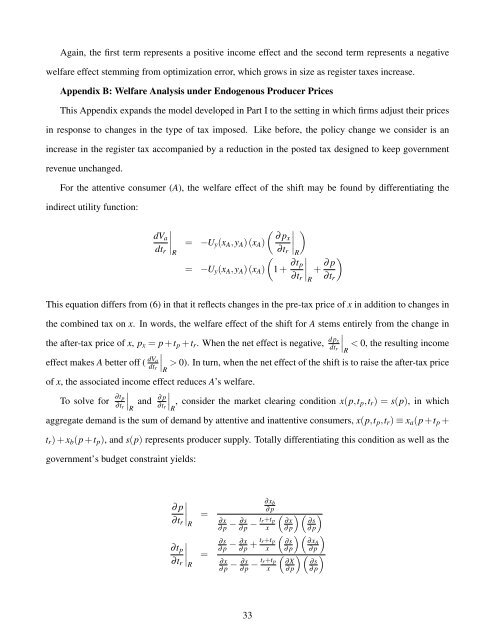Goldin & Homonoff - DataSpace at Princeton University
Goldin & Homonoff - DataSpace at Princeton University
Goldin & Homonoff - DataSpace at Princeton University
You also want an ePaper? Increase the reach of your titles
YUMPU automatically turns print PDFs into web optimized ePapers that Google loves.
Again, the first term represents a positive income effect and the second term represents a neg<strong>at</strong>ive<br />
welfare effect stemming from optimiz<strong>at</strong>ion error, which grows in size as register taxes increase.<br />
Appendix B: Welfare Analysis under Endogenous Producer Prices<br />
This Appendix expands the model developed in Part I to the setting in which firms adjust their prices<br />
in response to changes in the type of tax imposed. Like before, the policy change we consider is an<br />
increase in the register tax accompanied by a reduction in the posted tax designed to keep government<br />
revenue unchanged.<br />
For the <strong>at</strong>tentive consumer (A), the welfare effect of the shift may be found by differenti<strong>at</strong>ing the<br />
indirect utility function:<br />
<br />
dVa <br />
<br />
dtr<br />
R<br />
<br />
∂ px <br />
= −Uy(xA,yA)(xA) <br />
∂tr<br />
<br />
R<br />
= −Uy(xA,yA)(xA) 1 + ∂tp<br />
<br />
<br />
<br />
∂tr<br />
R<br />
+ ∂ p<br />
<br />
∂tr<br />
This equ<strong>at</strong>ion differs from (6) in th<strong>at</strong> it reflects changes in the pre-tax price of x in addition to changes in<br />
the combined tax on x. In words, the welfare effect of the shift for A stems entirely from the change in<br />
<br />
d px <br />
the after-tax price of x, px = p +tp +tr. When the net effect is neg<strong>at</strong>ive, < 0, the resulting income<br />
dtr R<br />
effect makes A better off ( dVa<br />
<br />
<br />
> 0). In turn, when the net effect of the shift is to raise the after-tax price<br />
dtr R<br />
of x, the associ<strong>at</strong>ed income effect reduces A’s welfare.<br />
To solve for ∂tp<br />
<br />
∂ p<br />
and , consider the market clearing condition x(p,tp,tr) = s(p), in which<br />
R R<br />
∂tr<br />
∂tr<br />
aggreg<strong>at</strong>e demand is the sum of demand by <strong>at</strong>tentive and in<strong>at</strong>tentive consumers, x(p,tp,tr) ≡ xa(p +tp +<br />
tr) + xb(p +tp), and s(p) represents producer supply. Totally differenti<strong>at</strong>ing this condition as well as the<br />
government’s budget constraint yields:<br />
<br />
∂ p<br />
<br />
∂tr<br />
R<br />
<br />
∂tp <br />
<br />
∂tr<br />
R<br />
=<br />
=<br />
∂xb<br />
∂ p<br />
∂x ∂s tr+tp<br />
∂ p − ∂ p − x<br />
∂s ∂x tr+tp<br />
∂ p − ∂ p + x<br />
∂x ∂s tr+tp<br />
∂ p − ∂ p − x<br />
33<br />
<br />
∂x ∂s<br />
∂ p<br />
∂ p<br />
<br />
∂s ∂xA<br />
∂ p ∂ p<br />
<br />
∂X<br />
∂ p<br />
∂s<br />
∂ p
















